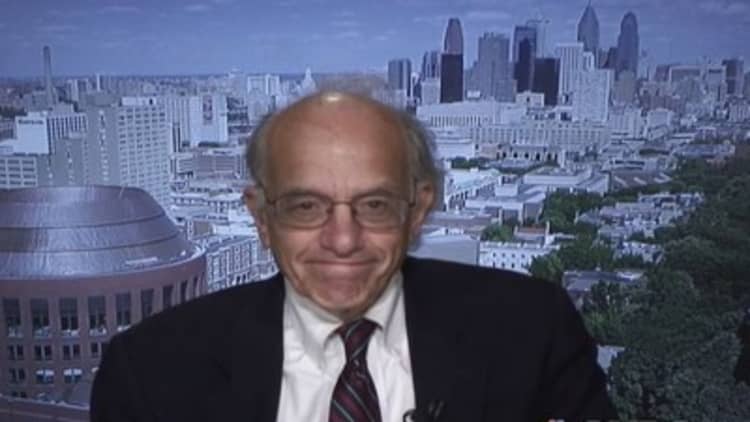
No, Jeremy Siegel doesn't think the will hit 21,000 this year.
But the uber-bullish Wharton professor of finance said that the index, which hit an all-time high on Tuesday, has further to climb.
"I see the bull market continuing," he said. "Economic news has been really quite strong. Second-quarter earnings were strong. Full-year S&P earnings are expected at $120, and even at a 2,000 level that's 16½ times earnings, which really, in a low-interest-rate environment, is cheap, in my opinion."
On CNBC's "Halftime Report," when the Dow was trading around 17,100, Siegel said his target remained at 18,000, or about 5 percent higher.
Read More 4 stocks to buy at all-time highs: 'Fast Money' pros
What about Dow 19,000?
"No, it wouldn't surprise me," he said. "It's very hard to give a point estimate of the Dow or any index, that we know how much short-term variability there is. Late last year, I said 18,000, and of course, it could go higher. And of course, it might not reach there. But I think we're on track for an 18,000 Dow by year end."
Multiple expansion in excess of 16½ times earnings could conceivably push the Dow to 21,000 or higher, but Siegel said he didn't think that was likely.
"That's more rarified air," he said. "We're not going there. That's really too high."
But, he added, "Certainly, this bull market could continue."
Siegel wrote off geopolitical risk.
Read More We're 5 years into a 20-year bull stock market: Pro
"Remember, bull markets climb the wall of worry. You know, what's going on in the Mideast, Ukraine—those are the worries. Bull markets top off when no one sees a problem on the horizon, everyone is in, there's no one else to come in," he said. "We are not at that area, and we know the public is still very gingerly putting their toes in this market with disbelief. That does not mark a top of the market. And that's why I think this bull has room to run."
Siegel didn't see the Federal Reserve's expected reduction of asset purchases as much of a headwind, either.
"So, if the Fed eases in March or April instead of late in the summer (of 2015), so it goes to 50 basis points, is that going to end the bull market? I mean, that is still unbelievably low compared to anything historical," he said. "So, the 10-year goes from 2½ to 3—and maybe even 3½—that's still extraordinarily low from any historical (perspective). And that's why, again, stocks have that wind of the interest rates going with them no matter when the Fed starts tightening."
—By CNBC's Bruno J. Navarro


